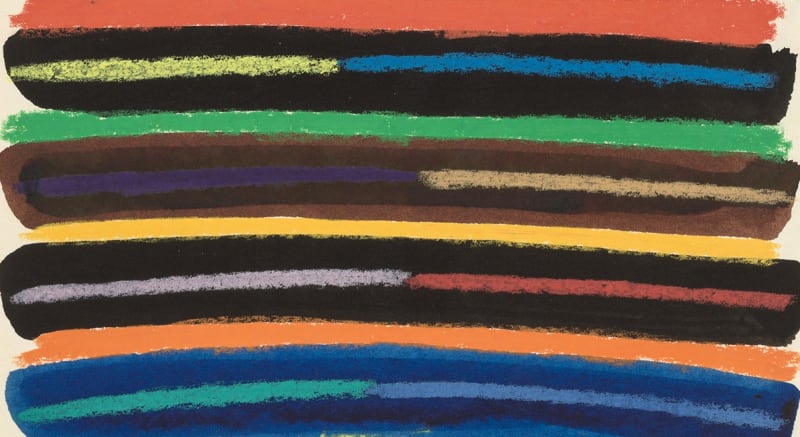Daniel LaRue Johnson (b. 1938, Los Angeles, CA – d. 2017, New York, USA) studied at Chouinard Art Institute (now California Institute of the Arts).
In the early 1960s whilst still living in California, Johnson was making assemblage works – graphic, dioramic constructions of objects, often repainted in black. At this time, which is referred to as his “black box” period, Johnson was part of a pioneering community of artists engaging politically and creatively with the Civil Rights movement. These works question the treatment of civil rights protestors from a personal perspective. In 1964, Johnson was invited by John Weber to participate in an exhibition entitled Boxes at Dwan Gallery, which presented his confrontational assemblages alongside modernists such as Marcel Duchamp and Kurt Schwitters.
In 1965 Johnson was awarded a Guggenheim Fellowship, the grant allowed him to move to Paris where he studied under Alberto Giacometti. Following Giacometti’s death in 1966, he returned to the United States with his family, settling in New York City. The artist’s return to the US coincided with a shift in the focus of his work. Immersed in New York’s dynamic creative environment, Johnson abandoned his assemblage “black boxes” to instead focus on colourful abstract paintings and minimalist sculptures, more aligned with a New York aesthetic.
Johnson’s work became more concerned with colour, line and surface. Courtney J. Martin suggests that ‘Johnson’s sculptures from the late 1960s into the 1970s reflect what he had always strived for in his work: utmost craftsmanship.’[1] Johnson also brought in musical references, his interest in bebop jazz was translated into colour – visualising musical notes and chords. Friend and fellow artist, Frank Bowling discussed Johnson’s work in 1969, stating: ‘Johnson’s instinctive understanding of the linear aspects of certain African sculptures locked in an intense marriage with current “striped paintings” a rebirth completely fresh and triumphant. Yet on a knife edge of trouble and questioning.’[2]
Alongside colourful works of painted wood, Johnson developed minimalist steel sculptures, one of his best-known public works being Peace Form One, which commemorates Ralph Bunche, the first black American Nobel Peace Prize laureate. The 20-ton, 50 ft. sculpture was dedicated on 15th September 1980 in a park for Bunche in New York City.
Johnson first exhibited in community venues, and later in academic settings as well as established Los Angeles galleries. In 1971, his work was included in the historically significant DeLuxe Show, which was one of the first racially integrated exhibitions in the United States – supported by the Menil family, also including artists such as Al Loving, Sam Gilliam, Virginia Jaramillo, Kenneth Noland and Jules Olitski. Johnson’s artwork has since enjoyed a rich exhibition history, including Whitney Museum of American Art, the Guggenheim Museum and the Museum of Modern Art (all NY, USA). In 2011, Johnson’s work was featured prominently in the historic exhibition Now Dig This!: Art and Black Los Angeles 1960 – 1980 at the Hammer Museum in Los Angeles. In 2017, Johnson’s work was featured in Tate Modern’s Soul of a Nation: Art in the Age of Black Power (London, UK) which toured to Crystal Bridges Museum of American Art (AR, USA); Brooklyn Museum (NY, USA); the Broad (CA, USA) and de Young Fine Arts Museum of San Francisco (CA, USA). Johnson’s work is in many prestigious public collections, including: Museum of Modern Art (NY, USA); Whitney Museum of American Art (NY, USA); California African American Museum (CA, USA); San Francisco Museum of Modern Art (CA, USA) and the Guggenheim Museum (NY, USA)
[1] Martin, C.J. Daniel LaRue Johnson https://hammer.ucla.edu/now-dig-this/artists/daniel-larue-johnson [Accessed: 8.11.19]
[2] Bowling, F. Discussion on Black Art in Arts Magazine issue 11, May 1969.
